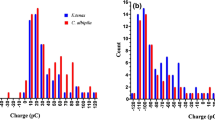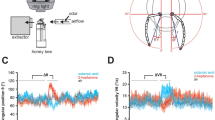Abstract
FIVE pairs of wind-sensitive hair beds at the upper part of the head control flight posture and wing movement of locusts1–7. But the antennae of flies and bees are airflow receptors which regulate the insect's flight speed relative to the surrounding air and stabilize the flight course in the horizontal plane8–12. During tethered flight these insects hold their antennae in a characteristic flight position. Exposed to the air current of a wind tunnel, they will move their antennae actively against the direction of the air current. This movement is considered as an antennal positioning reaction, which adapts the operating range of the receptor to different air speeds10–12.
This is a preview of subscription content, access via your institution
Access options
Subscribe to this journal
Receive 51 print issues and online access
$199.00 per year
only $3.90 per issue
Buy this article
- Purchase on Springer Link
- Instant access to full article PDF
Prices may be subject to local taxes which are calculated during checkout
Similar content being viewed by others
References
Boyd, K., and Ewer, D. W., S. Afric. Sci., 2, 168 (1949).
Weis-Fogh, T., Nature, 164, 873 (1949).
Weis-Fogh, T., Phil. Trans. Roy. Soc., B, 239, 553 (1956).
Haskell, P. T., Proc. Fifteenth Int. Cong. Zool., London, 1958, 960 (1959).
Wilson, D. M., J. Exp. Biol., 38, 471 (1961).
Guthrie, D. M., Quart. J. Micros. Sci., 105, 183 (1964).
Camhi, J. M., J. Exp. Biol., 50, 335 (1969).
Hollick, F. S. J., Phil. Trans. Roy. Soc., B, 230, 357 (1941).
Burkhardt, D., and Schneider, G., Z. Naturforsch., 12b139 (1957).
Heran, H., Z. vergl. Physiol., 42, 103 (1959).
Burkhardt, D., and Gewecke, M., Cold Spring Harbor Symp. Quant. Biol., 30, 601 (1965).
Gewecke, M., Z. vergl. Physiol., 54, 121 (1967).
Albrecht, F. O., The Anatomy of the Migratory Locust (Athlone Press, London, 1953).
Jannone, G., Boll. Lab. Ent. agr. Portici, 4, 1 (1940).
Eggers, F., Zool. Bausteine, 2, 1 (1928).
Debauche, H., Proc. Fifth Int. Locust Conf. Brussels, 417 (1938).
Uvarov, B., Grasshoppers and Locusts, 1 (Cambridge University Press, 1966).
Uchiyama, H., and Katsuki, Y., Physiol. Comp. (Oecol.), 4, 154 (1956).
Author information
Authors and Affiliations
Rights and permissions
About this article
Cite this article
GEWECKE, M. Antennae: Another Wind-sensitive Receptor in Locusts. Nature 225, 1263–1264 (1970). https://doi.org/10.1038/2251263a0
Received:
Revised:
Issue Date:
DOI: https://doi.org/10.1038/2251263a0
This article is cited by
-
Central projections from Johnston’s organ in the locust: Axogenesis and brain neuroarchitecture
Development Genes and Evolution (2023)
-
Vision and air flow combine to streamline flying honeybees
Scientific Reports (2013)
-
Antennae in the hawkmoth Manduca sexta (Lepidoptera, Sphingidae) mediate abdominal flexion in response to mechanical stimuli
Journal of Comparative Physiology A (2010)
-
Control of hindlimb posture by wind-sensitive hairs and antennae during locust flight
Journal of Comparative Physiology A (1986)
-
The flight maintenance mechanism in the cockroachPeriplaneta americana L.
Journal of Comparative Physiology A (1984)
Comments
By submitting a comment you agree to abide by our Terms and Community Guidelines. If you find something abusive or that does not comply with our terms or guidelines please flag it as inappropriate.



